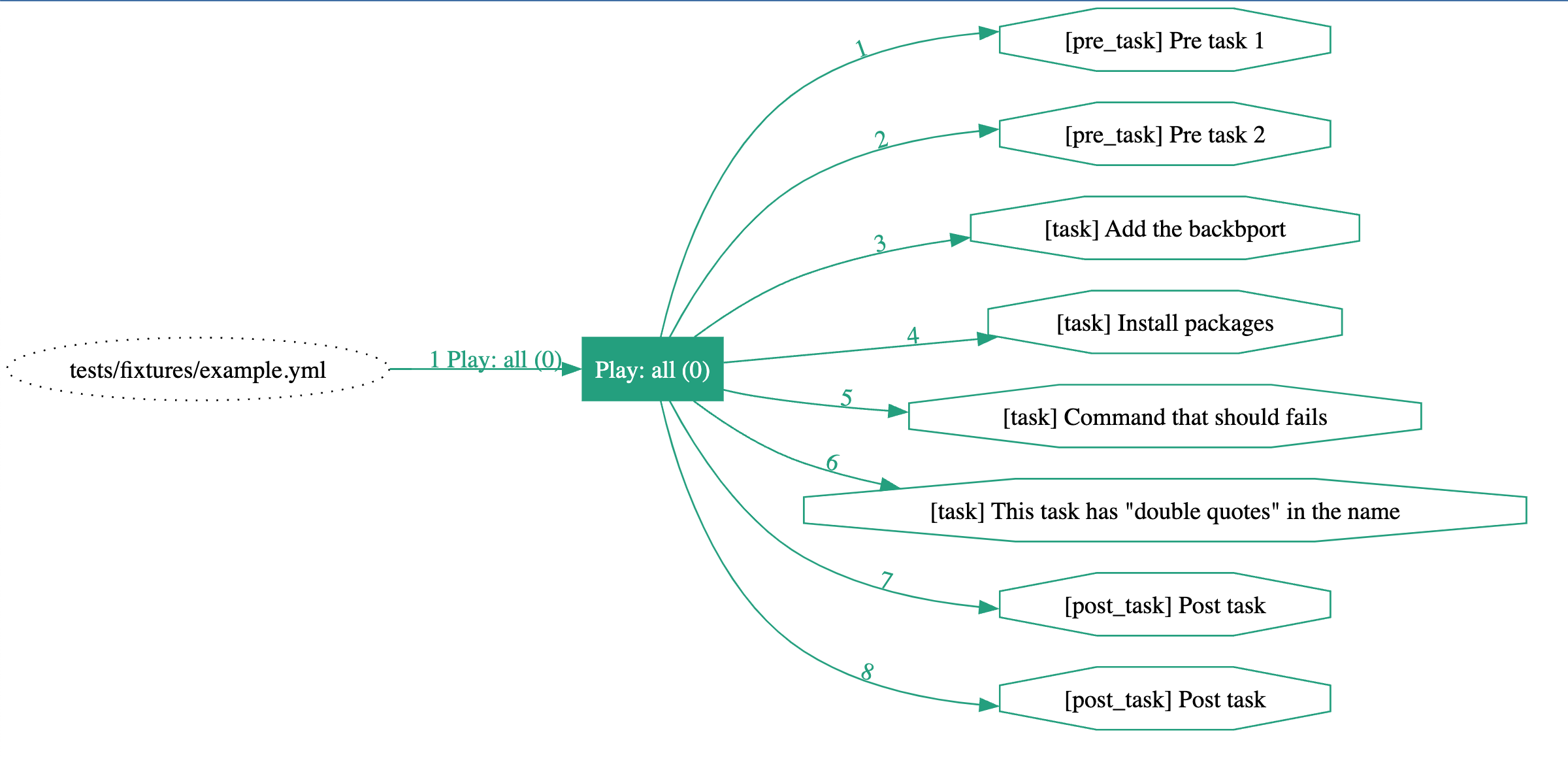A command line tool to create a graph representing your Ansible playbook tasks and roles
Project description
Ansible Playbook Grapher
ansible-playbook-grapher is a command line tool to create a graph representing your Ansible playbook plays, tasks and roles. The aim of this project is to have an overview of your playbook.
Inspired by Ansible Inventory Grapher.
Features
The following features are available when opening the SVGs in a browser (recommended) or a viewer that supports JavaScript:
- Highlighting of all the related nodes of a given node when clicking or hovering. Example: Click on a role to select
all its tasks when
--include-role-tasksis set. - A double click on a node opens its corresponding file or folders depending on if it's the playbook, a play, a task or
a role. By default, the browser will open folders and download files since it may not be able to render the YAML
file.
Optionally, you can set the open protocol to use VSCode with--open-protocol-handler vscode: it will open the folders when double-clicking on roles (notinclude_role) and the files for the others nodes. The cursor will be at the task exact position in the file.
Lastly, you can provide your own protocol formats with--open-protocol-handler custom --open-protocol-custom-formats '{}'. See the help and an example. - Filer tasks based on tags
- Export the dot file using to generate the graph with Graphviz.
Prerequisites
- Python 3.8 at least
- A virtual environment from which to run the grapher. This is highly recommended because the grapher depends on
some versions of ansible-core which are not necessarily installed in your environment and may cause issues if you use
some older versions of Ansible (
since
ansiblepackage has been split). - Graphviz: The tool used to generate the graph in SVG.
$ sudo apt-get install graphviz # or yum install or brew install
I try to respect Red Hat Ansible Engine Life Cycle for the supported Ansible version.
Installation
pip install ansible-playbook-grapher
Usage
ansible-playbook-grapher tests/fixtures/example.yml
ansible-playbook-grapher --include-role-tasks tests/fixtures/with_roles.yml
ansible-playbook-grapher tests/fixtures/with_block.yml
Note on block: Since blocks are logical group of tasks, the conditional when is not displayed on the edges pointing
to them but on the tasks inside the block. This
mimics Ansible behavior
regarding the blocks.
CLI options
The available options:
ansible-playbook-grapher --help
usage: ansible-playbook-grapher [-h] [-v] [-i INVENTORY] [--include-role-tasks] [-s] [--view] [-o OUTPUT_FILENAME]
[--open-protocol-handler {default,vscode,custom}] [--open-protocol-custom-formats OPEN_PROTOCOL_CUSTOM_FORMATS] [--version]
[-t TAGS] [--skip-tags SKIP_TAGS] [--vault-id VAULT_IDS]
[--ask-vault-password | --vault-password-file VAULT_PASSWORD_FILES] [-e EXTRA_VARS]
playbook
Make graphs from your Ansible Playbooks.
positional arguments:
playbook Playbook to graph
optional arguments:
--ask-vault-password, --ask-vault-pass
ask for vault password
--include-role-tasks Include the tasks of the role in the graph.
--open-protocol-custom-formats OPEN_PROTOCOL_CUSTOM_FORMATS
The custom formats to use as URLs for the nodes in the graph. Required if --open-protocol-handler is set to custom. You should
provide a JSON formatted string like: {"file": "", "folder": ""}. Example: If you want to open folders (roles) inside the browser
and files (tasks) in vscode, set this to '{"file": "vscode://file/{path}:{line}:{column}", "folder": "{path}"}'
--open-protocol-handler {default,vscode,custom}
The protocol to use to open the nodes when double-clicking on them in your SVG viewer. Your SVG viewer must support double-click
and Javascript. The supported values are 'default', 'vscode' and 'custom'. For 'default', the URL will be the path to the file or
folders. When using a browser, it will open or download them. For 'vscode', the folders and files will be open with VSCode. For
'custom', you need to set a custom format with --open-protocol-custom-formats.
--skip-tags SKIP_TAGS
only run plays and tasks whose tags do not match these values
--vault-id VAULT_IDS the vault identity to use
--vault-password-file VAULT_PASSWORD_FILES, --vault-pass-file VAULT_PASSWORD_FILES
vault password file
--version show program's version number and exit
--view Automatically open the resulting SVG file with your system’s default viewer application for the file type
-e EXTRA_VARS, --extra-vars EXTRA_VARS
set additional variables as key=value or YAML/JSON, if filename prepend with @
-h, --help show this help message and exit
-i INVENTORY, --inventory INVENTORY
specify inventory host path or comma separated host list.
-o OUTPUT_FILENAME, --output-file-name OUTPUT_FILENAME
Output filename without the '.svg' extension. Default: <playbook>.svg
-s, --save-dot-file Save the dot file used to generate the graph.
-t TAGS, --tags TAGS only run plays and tasks tagged with these values
-v, --verbose verbose mode (-vvv for more, -vvvv to enable connection debugging)
Configuration: ansible.cfg
The content of ansible.cfg is loaded automatically when running the grapher according to Ansible's behavior. The
corresponding environment variables are also loaded.
The values in the config file (and their corresponding environment variables) may affect the behavior of the grapher.
For example TAGS_RUN and TAGS_SKIP or vault configuration.
More information here.
Limitations
Since Ansible Playbook Grapher is a static analyzer that parses your playbook, it's limited to what can be determined statically: no task is run against your inventory.
The parser tries to interpolate the variables, but some of them are only available when running your playbook (
ansible_os_family, ansible_system, etc.). The tasks inside any import_* or include_* with some variables in their
arguments may not appear in the graph.
Contribution
Contributions are welcome. Feel free to contribute by creating an issue or submitting a PR :smiley:
Dev environment
To setup a new development environment :
- Install graphviz (see above)
- (cd tests && pip install -r requirements_tests.txt)
Run the tests and open the generated files in your system’s default viewer application:
export TEST_VIEW_GENERATED_FILE=1
$ make test # run all tests
The graphs are generated in the folder tests/generated_svg. They are also generated as artefacts
in Github Actions. Feel free to look at them when
submitting PRs.
License
GNU General Public License v3.0 or later (Same as Ansible)
See LICENSE for the full text
Project details
Release history Release notifications | RSS feed
Download files
Download the file for your platform. If you're not sure which to choose, learn more about installing packages.
Source Distributions
Built Distribution
Hashes for ansible_playbook_grapher-1.1.0-py2.py3-none-any.whl
| Algorithm | Hash digest | |
|---|---|---|
| SHA256 | d517c67c5b42a975e15da25d4f8050012fd033d300673e0d72fbc7c175c4dd64 |
|
| MD5 | 5a1f25af41c7e46d648dbbdcabfd9863 |
|
| BLAKE2b-256 | 5c84efdc8714ac80e311e1666933b5c48ba30eb303a359e1c7c8804651287217 |

















